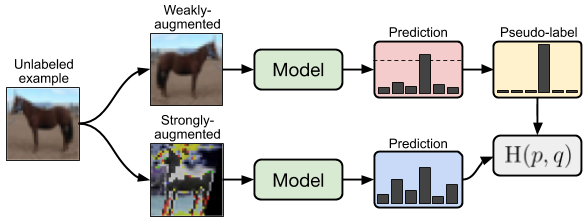FixMatch
Code for the paper: "FixMatch: Simplifying Semi-Supervised Learning with Consistency and Confidence" by Kihyuk Sohn, David Berthelot, Chun-Liang Li, Zizhao Zhang, Nicholas Carlini, Ekin D. Cubuk, Alex Kurakin, Han Zhang, and Colin Raffel.
This is not an officially supported Google product.
Setup
Important: ML_DATA is a shell environment variable that should point to the location where the datasets are installed. See the Install datasets section for more details.
Install dependencies
sudo apt install python3-dev python3-virtualenv python3-tk imagemagick
virtualenv -p python3 --system-site-packages env3
. env3/bin/activate
pip install -r requirements.txtInstall datasets
export ML_DATA="path to where you want the datasets saved"
export PYTHONPATH=$PYTHONPATH:"path to the FixMatch"
# Download datasets
CUDA_VISIBLE_DEVICES= ./scripts/create_datasets.py
cp $ML_DATA/svhn-test.tfrecord $ML_DATA/svhn_noextra-test.tfrecord
# Create unlabeled datasets
CUDA_VISIBLE_DEVICES= scripts/create_unlabeled.py $ML_DATA/SSL2/svhn $ML_DATA/svhn-train.tfrecord $ML_DATA/svhn-extra.tfrecord &
CUDA_VISIBLE_DEVICES= scripts/create_unlabeled.py $ML_DATA/SSL2/svhn_noextra $ML_DATA/svhn-train.tfrecord &
CUDA_VISIBLE_DEVICES= scripts/create_unlabeled.py $ML_DATA/SSL2/cifar10 $ML_DATA/cifar10-train.tfrecord &
CUDA_VISIBLE_DEVICES= scripts/create_unlabeled.py $ML_DATA/SSL2/cifar100 $ML_DATA/cifar100-train.tfrecord &
CUDA_VISIBLE_DEVICES= scripts/create_unlabeled.py $ML_DATA/SSL2/stl10 $ML_DATA/stl10-train.tfrecord $ML_DATA/stl10-unlabeled.tfrecord &
wait
# Create semi-supervised subsets
for seed in 0 1 2 3 4 5; do
for size in 10 20 30 40 100 250 1000 4000; do
CUDA_VISIBLE_DEVICES= scripts/create_split.py --seed=$seed --size=$size $ML_DATA/SSL2/svhn $ML_DATA/svhn-train.tfrecord $ML_DATA/svhn-extra.tfrecord &
CUDA_VISIBLE_DEVICES= scripts/create_split.py --seed=$seed --size=$size $ML_DATA/SSL2/svhn_noextra $ML_DATA/svhn-train.tfrecord &
CUDA_VISIBLE_DEVICES= scripts/create_split.py --seed=$seed --size=$size $ML_DATA/SSL2/cifar10 $ML_DATA/cifar10-train.tfrecord &
done
for size in 400 1000 2500 10000; do
CUDA_VISIBLE_DEVICES= scripts/create_split.py --seed=$seed --size=$size $ML_DATA/SSL2/cifar100 $ML_DATA/cifar100-train.tfrecord &
done
CUDA_VISIBLE_DEVICES= scripts/create_split.py --seed=$seed --size=1000 $ML_DATA/SSL2/stl10 $ML_DATA/stl10-train.tfrecord $ML_DATA/stl10-unlabeled.tfrecord &
wait
done
CUDA_VISIBLE_DEVICES= scripts/create_split.py --seed=1 --size=5000 $ML_DATA/SSL2/stl10 $ML_DATA/stl10-train.tfrecord $ML_DATA/stl10-unlabeled.tfrecordImageNet
Codebase for ImageNet experiments located in the imagenet subdirectory.
Running
Setup
All commands must be ran from the project root. The following environment variables must be defined:
export ML_DATA="path to where you want the datasets saved"
export PYTHONPATH=$PYTHONPATH:.Example
For example, training a FixMatch with 32 filters on cifar10 shuffled with seed=3, 40 labeled samples and 1
validation sample:
CUDA_VISIBLE_DEVICES=0 python fixmatch.py --filters=32 --dataset=cifar10.3@40-1 --train_dir ./experiments/fixmatchAvailable labelled sizes are 10, 20, 30, 40, 100, 250, 1000, 4000. For validation, available sizes are 1, 5000. Possible shuffling seeds are 1, 2, 3, 4, 5 and 0 for no shuffling (0 is not used in practiced since data requires to be shuffled for gradient descent to work properly).
Multi-GPU training
Just pass more GPUs and fixmatch automatically scales to them, here we assign GPUs 4-7 to the program:
CUDA_VISIBLE_DEVICES=4,5,6,7 python fixmatch.py --filters=32 --dataset=cifar10.3@40-1 --train_dir ./experiments/fixmatchFlags
python fixmatch.py --help
# The following option might be too slow to be really practical.
# python fixmatch.py --helpfull
# So instead I use this hack to find the flags:
fgrep -R flags.DEFINE libml fixmatch.pyThe --augment flag can use a little more explanation. It is composed of 3 values, for example d.d.d
(d=default augmentation, for example shift/mirror, x=identity, e.g. no augmentation, ra=rand-augment,
rac=rand-augment + cutout):
- the first
drefers to data augmentation to apply to the labeled example. - the second
drefers to data augmentation to apply to the weakly augmented unlabeled example. - the third
drefers to data augmentation to apply to the strongly augmented unlabeled example. For the strong augmentation,dis followed byCTAugmentforfixmatch.pyand code insidecta/folder.
Valid dataset names
for dataset in cifar10 svhn svhn_noextra; do
for seed in 0 1 2 3 4 5; do
for valid in 1 5000; do
for size in 10 20 30 40 100 250 1000 4000; do
echo "${dataset}.${seed}@${size}-${valid}"
done; done; done; done
for seed in 1 2 3 4 5; do
for valid in 1 5000; do
echo "cifar100.${seed}@10000-${valid}"
done; done
for seed in 1 2 3 4 5; do
for valid in 1 5000; do
echo "stl10.${seed}@1000-${valid}"
done; done
echo "stl10.1@5000-1"Monitoring training progress
You can point tensorboard to the training folder (by default it is --train_dir=./experiments) to monitor the training
process:
tensorboard.sh --port 6007 --logdir ./experimentsCheckpoint accuracy
We compute the median accuracy of the last 20 checkpoints in the paper, this is done through this code:
# Following the previous example in which we trained cifar10.3@250-5000, extracting accuracy:
./scripts/extract_accuracy.py ./experiments/fixmatch/cifar10.d.d.d.3@40-1/CTAugment_depth2_th0.80_decay0.990/FixMatch_archresnet_batch64_confidence0.95_filters32_lr0.03_nclass10_repeat4_scales3_uratio7_wd0.0005_wu1.0/
# The command above will create a stats/accuracy.json file in the model folder.
# The format is JSON so you can either see its content as a text file or process it to your liking.Adding datasets
You can add custom datasets into the codebase by taking the following steps:
- Add a function to acquire the dataset to
scripts/create_datasets.pysimilar to the present ones, e.g._load_cifar10. You need to call_encode_pngto create encoded strings from the original images. The created function should return a dictionary of the format{'train' : {'images': <encoded 4D NHWC>, 'labels': <1D int array>}, 'test' : {'images': <encoded 4D NHWC>, 'labels': <1D int array>}}. - Add the dataset to the variable
CONFIGSinscripts/create_datasets.pywith the previous function as loader. You can now run thecreate_datasetsscript to obtain a tf record for it. - Use the
create_unlabeledandcreate_splitscript to create unlabeled and differently split tf records as above in the Install Datasets section. - In
libml/data.pyadd your dataset in thecreate_datasetsfunction. The specified "label" for the dataset has to match the created splits for your dataset. You will need to specify the corresponding variables if your dataset has a different # of classes than 10 and different resolution and # of channels than 32x32x3 - In
libml/augment.pyadd your dataset to theDEFAULT_AUGMENTvariable. Primitives "s", "m", "ms" represent mirror, shift and mirror+shift.
Citing this work
@article{sohn2020fixmatch,
title={FixMatch: Simplifying Semi-Supervised Learning with Consistency and Confidence},
author={Kihyuk Sohn and David Berthelot and Chun-Liang Li and Zizhao Zhang and Nicholas Carlini and Ekin D. Cubuk and Alex Kurakin and Han Zhang and Colin Raffel},
journal={arXiv preprint arXiv:2001.07685},
year={2020},
}
